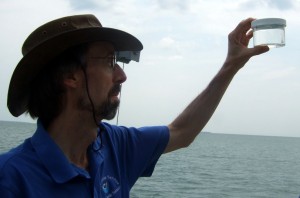 |
| Rick Stumpf testing water for algae: NOAA scientist Rick Stumpf shows local researchers what to look for in detecting toxic algae. Credit: OSU’s Stone Lab |
LEAD IN: Last year’s record-setting Lake Erie algae bloom hurt many tourism businesses like charter fishing and resorts that depend on clean water and beaches. The high concentrations of toxins from the blue-green algae also meant cities like Toledo had to spend more money to clean up drinking water. This summer, federal researchers unveiled a new tool for forecasting seasonal algae blooms. Independent producer Karen Schaefer reports that scientists are hoping it can help cities and businesses across the Great Lakes and the nation plan ahead.
SCHAEFER: This year, the thick ooze of green slime that coated docks and bays in western Lake Erie in 2011 is gone. That’s largely thanks to the drought, which reduced rainfall and nutrient runoff from farms and cities. But National Oceanic and Atmospheric Administration researcher Rick Stumpf was taking no chances back in July, when he tested the water near Put-in-Bay in Lake Erie for chorophyll and phycocyanin, the pigment that’s produced by toxic blue-green algae.
Great Lakes Echo
08 Oct 2012
K Schaefer

This comment has been removed by a blog administrator.
ReplyDelete